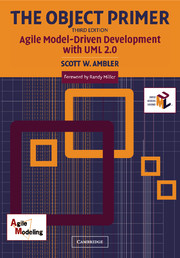Book contents
- Frontmatter
- Contents
- Acknowledgments
- Foreword
- Preface
- About the Author
- Chapter 1 Leading-Edge Software Development
- Chapter 2 Understanding the Basics–Object-Oriented Concepts
- Chapter 3 Full Lifecycle Object-Oriented Testing (FLOOT)
- Chapter 4 Agile Model–Driven Development (AMDD)
- Chapter 5 Usage Modeling
- Chapter 6 User-Interface Development
- Chapter 7 Supplementary Requirements
- Chapter 8 Conceptual Domain Modeling
- Chapter 9 Business Process Modeling
- Chapter 10 Agile Architecture
- Chapter 11 Dynamic Object Modeling
- Chapter 12 Structural Design Modeling
- Chapter 13 Object-Oriented Programming
- Chapter 14 Agile Database Development
- Chapter 15 Where to Go from Here
- Glossary
- References and Recommended Reading
- Index
Chapter 1 - Leading-Edge Software Development
Published online by Cambridge University Press: 03 March 2010
- Frontmatter
- Contents
- Acknowledgments
- Foreword
- Preface
- About the Author
- Chapter 1 Leading-Edge Software Development
- Chapter 2 Understanding the Basics–Object-Oriented Concepts
- Chapter 3 Full Lifecycle Object-Oriented Testing (FLOOT)
- Chapter 4 Agile Model–Driven Development (AMDD)
- Chapter 5 Usage Modeling
- Chapter 6 User-Interface Development
- Chapter 7 Supplementary Requirements
- Chapter 8 Conceptual Domain Modeling
- Chapter 9 Business Process Modeling
- Chapter 10 Agile Architecture
- Chapter 11 Dynamic Object Modeling
- Chapter 12 Structural Design Modeling
- Chapter 13 Object-Oriented Programming
- Chapter 14 Agile Database Development
- Chapter 15 Where to Go from Here
- Glossary
- References and Recommended Reading
- Index
Summary
Modern software development requires modern ways of working.
The only constant in the information technology (IT) industry is change. To remain employable, let alone effective, software developers must continually take the time to identify and then understand the latest development approaches. The goal of this chapter is to introduce you to leading-edge technologies and techniques that enable you to succeed at developing modern business systems. I will try to steer you through the marketing hype surrounding these approaches, and in one case try to dissuade you from adopting it—just because something is new and well hyped does not mean that it has much of a future. In short, this chapter provides you with a foundation for reading the rest of this book.
This chapter discusses
Modern development technologies;
Modern development techniques;
How this book is organized; and
The case studies.
MODERN DEVELOPMENT TECHNOLOGIES
Effective developers understand the fundamentals of the technologies that they have available to them. The good news is that we have many technologies available to us; the bad news is that we have many technologies available to us.
Figure 1.1, which depicts a high-level architecture detailing how these technologies are used together, shows how some applications may be n-tiered—an approach where application logic is implemented on several (n) categories of computing devices (tiers)—whereas others fall into the “fat client” approach where most business logic is implemented on the client. Object technology is used to implement all types of logic, including both business and system logic.
- Type
- Chapter
- Information
- The Object PrimerAgile Model-Driven Development with UML 2.0, pp. 1 - 22Publisher: Cambridge University PressPrint publication year: 2004

